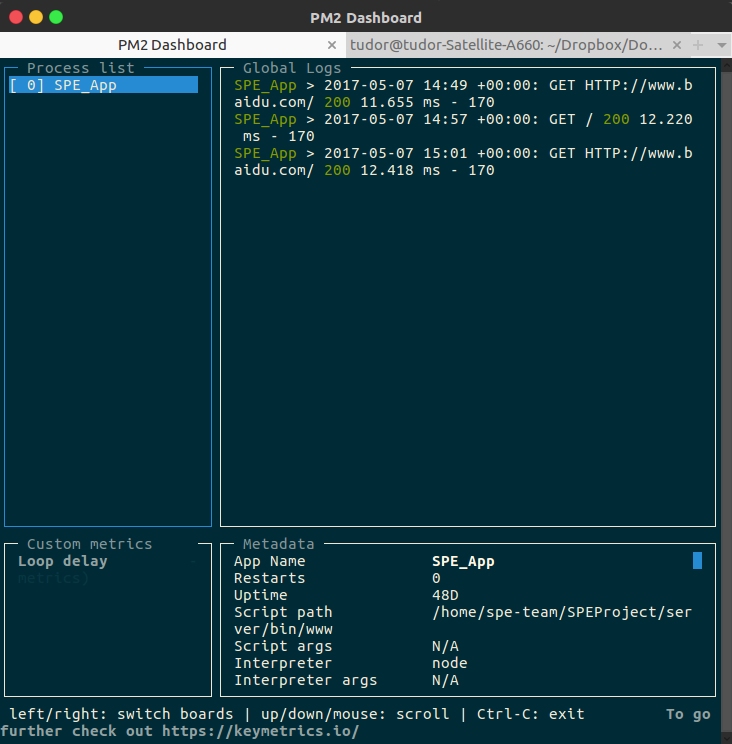

Now that your Node.js application is running and managed by PM2, let’s set up the reverse proxy. Note that running pm2 without any arguments will also display a help page with example usage. This displays the application status, CPU, and memory usage: The PM2 process monitor can be pulled up with the monit subcommand. Get information about a specific application using its App name: List the applications currently managed by PM2: Stop an application with this command (specify the PM2 App name or id): In addition to those we have covered, PM2 provides many subcommands that allow you to manage or look up information about your applications. If at this point you encounter an error, you may need to reboot, which you can achieve with sudo reboot.įor a detailed overview of systemd, please review Systemd Essentials: Working with Services, Units, and the Journal. This pm2 instance, in turn, runs hello.js. You have now created a systemd unit that runs pm2 for your user on boot. sudo env PATH = $PATH:/usr/bin /usr/lib/node_modules/pm2/bin/pm2 startup systemd -u sammy -hp /home/ sammyĪs an additional step, we can save the PM2 process list and corresponding environments:.Run the command from the output, with your username in place of sammy: Sudo env PATH=$PATH:/usr/bin /usr/lib/node_modules/pm2/bin/pm2 startup systemd -u sammy -hp /home/ sammy To setup the Startup Script, copy/paste the following command: The last line of the resulting output will include a command to run with superuser privileges in order to set PM2 to start on boot: This subcommand generates and configures a startup script to launch PM2 and its managed processes on server boots: PM2 also maintains other information, such as the PID of the process, its current status, and memory usage.Īpplications that are running under PM2 will be restarted automatically if the application crashes or is killed, but we can take an additional step to get the application to launch on system startup using the startup subcommand. │ id │ name │ mode │ ↺ │ status │ cpu │ memory │ Starting /home/sammy/hello.js in fork_mode (1 instance) Spawning PM2 daemon with pm2_home=/home/sammy/.pm2 To check which version of Node.js you have installed after these initial steps, type:
#MONIT NODEJS INSTALL#
After running the setup script from Nodesource, you can install the Node.js package: The PPA will be added to your configuration and your local package cache will be updated automatically. When you’re done inspecting the script, run it under sudo: You can inspect the contents of this script with nano or your preferred text editor: Make sure you’re in your home directory, and use curl to retrieve the installation script for the most recent LTS version of Node.js from its archives.

Let’s begin by installing the latest LTS release of Node.js, using the NodeSource package archives.įirst, install the NodeSource PPA in order to get access to its contents. When you’ve completed the prerequisites, you will have a server serving your domain’s default placeholder page at /.
#MONIT NODEJS HOW TO#
How To Secure Nginx with Let’s Encrypt on Ubuntu 20.04 will walk you through the process.

#MONIT NODEJS FREE#
The Nginx server will offer HTTPS using a free certificate provided by Let’s Encrypt.

This server will run a Node.js application managed by PM2, and provide users with secure access to the application through an Nginx reverse proxy. In this tutorial, you will set up a production-ready Node.js environment on a single Ubuntu 20.04 server. This means that they will restart on reboot or failure and are safe for use in a production environment. Though you can run Node.js applications at the command line, this tutorial will focus on running them as a service. The platform runs on Linux, macOS, FreeBSD, and Windows. Node.js is an open-source JavaScript runtime environment for building server-side and networking applications.


 0 kommentar(er)
0 kommentar(er)
